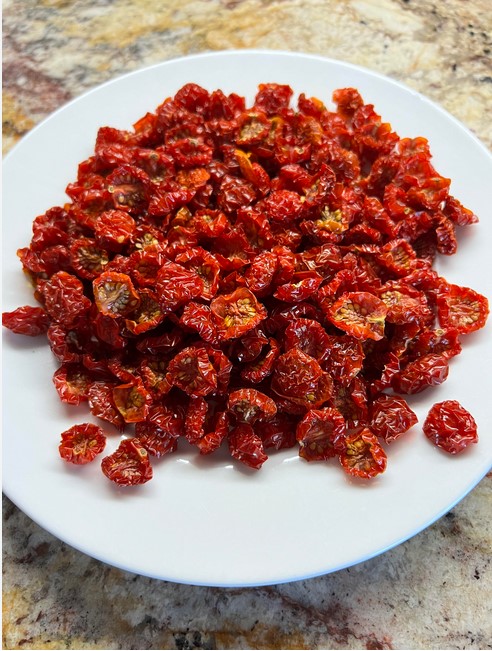Sun-dried tomatoes are a delicious, concentrated form of fresh tomatoes with a rich, tangy flavor. They can elevate everything from pastas and salads to sandwiches and sauces.
While you can buy sun-dried tomatoes at most grocery stores, making them at home allows you to control the ingredients and enjoy a traditional preservation method that enhances the natural sweetness of ripe tomatoes. In this guide, you’ll learn everything you need to know about how to sun-dry tomatoes the old-fashioned way.
Why Sun-Dry Tomatoes?
Table of Contents

Drying tomatoes in the sun is a method that dates back centuries, especially in Mediterranean climates where the weather is ideal.
This natural drying process removes most of the moisture from the fruit, preserving it for months without refrigeration.
When done correctly, sun-dried tomatoes retain their vibrant flavor and nutrients, making them a healthy addition to your pantry.
Steps to Sun-Dry Tomatoes
Follow this step-by-step guide to sun-dry tomatoes.
1. Choose the Right Tomatoes

The first step in making sun-dried tomatoes is selecting the right variety. Not all tomatoes are ideal for drying.
Best Varieties for Drying:
Roma (Plum) Tomatoes – These are the most popular choice because they have fewer seeds, thicker flesh, and lower water content.
San Marzano Tomatoes – Similar to Roma but often considered to have a sweeter, more robust flavor.
Cherry or Grape Tomatoes – These can also be dried and result in bite-sized flavor bombs, though the process takes a bit longer due to their skin-to-flesh ratio.
Avoid large, juicy slicing tomatoes like beefsteaks, as their high water content extends drying time and may invite mold or spoilage.
2. Preparation Steps

- Rinse the tomatoes thoroughly under cool water. Pat them dry with a clean kitchen towel or paper towel.
- Slice Roma tomatoes in half lengthwise. For cherry tomatoes, you can cut them in half or leave them whole if they’re small. Remove the core and most of the seeds if desired, especially for larger tomatoes.
- Sprinkle the cut sides with sea salt or kosher salt. Salt helps draw out moisture and enhances flavor. Optionally, add herbs like thyme, oregano, or rosemary for extra flavor.
3. Arrange for Drying

- Place the tomato,oes cut side up on drying racks or trays lined with cheesecloth or a fine mesh screen.
- Avoid placing them directly on metal trays unless they are stainless steel, as aluminum can react with the tomatoes.
- Sun-drying tomatoes takes time and the right conditions. You’ll need:
- Temperatures should be at least 85°F (29°C) during the day.
- Dry air is essential to prevent mold growth.
- Choose a spot with full sun exposure for at least 8 hours a day.
4. Choose a Safe Drying Area
- Set up your trays in a sunny, well-ventilated area that is free from dust and animals. Cover the trays with another layer of cheesecloth or netting to protect the tomatoes from insects and birds.
- Turn the tomatoes every day or two to ensure even drying. If you notice any mold, discard the affected pieces immediately.
- Depending on the weather and tomato size, sun-drying can take 4 to 10 days. The tomatoes are done when they feel leathery but not brittle. They should be dry but still pliable.
- After drying, place the tomatoes in airtight glass jars loosely packed. Shake the jars daily for a week to distribute any remaining moisture and prevent spoilage.
- Rotate trays and flip tomatoes daily.
- If conditions are too humid, discard moldy pieces immediately.
- Tomatoes may not be fully dried. Return them to the sun or finish in a low oven (about 135°F or 57°C) for a few hours.
5. Storage

- Store in a cool, dark place in airtight containers. Add a food-grade desiccant packet for longer shelf life.
- Store in freezer-safe bags for up to a year.
- Rehydrate the tomatoes in boiling water or vinegar, pat dry, and submerge in olive oil with herbs and garlic. Keep refrigerated and consume within two weeks.
How to Use Sun-Dried Tomatoes

Homemade sun-dried tomatoes can be used in numerous dishes:
- Soak in hot water or broth and blend into pasta sauces or soups.
- Add to pizzas, focaccias, or flatbreads.
- Chop and toss with mixed greens, feta, and olives for a Mediterranean twist.
- Add to paninis or wraps for a tangy punch of flavor.
- To rehydrate, soak dried tomatoes in hot water for 10–20 minutes, then use as desired. Save the soaking water for flavoring stocks or rice dishes.
Final Thoughts
Sun-drying tomatoes is a simple but rewarding process that allows you to enjoy the taste of summer all year long.
While it does require some patience and the right weather conditions, the end result is a pantry staple packed with flavor and versatility.
With just a few tools and a sunny spot, you can transform ripe tomatoes into gourmet-quality sun-dried treats at home.
Leave a Reply